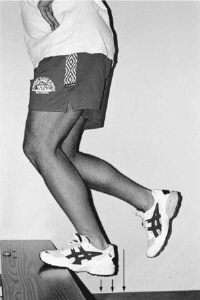A long term solution to your Achilles’ heel

Has your Achilles tendon kept you from training or competing? This is one nagging injury that seems to re-emerge at the most inopportune time…just when you are ramping up for an event or in a heavy part of your season schedule. For many people, their Achilles tendon seems to be the weak link. Although this tendon in relative terms is far from weak (bearing as much as 8-10 times a person’s body weight during strenuous exercise) it is a recurring problem for many that need an effective long term solution.
Long term solution for my Achilles tendon pain?…great, but I hope I don’t have to put too much effort into it! If you are a product of our Western medicine approach, this is likely your subconscious dialogue. We all love the quick fix; so for our Achilles pain we try things like orthotics, shock-wave therapy, platelet rich plasma (PRP) injections, corticosteroid injections and even surgery at times. Some of these may have a time and a place for consideration, but if you are looking for an effective long term solution look no further than eccentric exercises.
Eccentric exercises for the Achilles tendon have been widely accepted as a primary approach to treating mid-portion Achilles tendinopathy, and several other tendinopathies, through more than a decade of work by Alfredson and colleagues. His treatment program was originally described as 180 repetitions of heel drops, with the knee straight and bent, over a 12 week period (see videos below).
Although the mechanism for why eccentric exercises work so well (compared to other treatments and other forms of exercise) is still up for debate, there is ample evidence to conclude that it does have a significant benefit for the majority of patients.Check out the videos below to see how the protocol is implemented (disclaimer: you should consult a suitable health care professional to confirm the diagnosis of mid-portion achilles tendinopathy…there are several other considerations for pain in the region of the Achilles tendon for which eccentric exercises would not be recommended).
Most recently a follow up study demonstrated that the functional improvements (measured by the validated VISA-A score) continue to improve up to 5 years after the completion of the program. An interesting component of this study was that the majority of subjects (67%) had never performed the heel drop exercises after the 3 month protocol ended. So although the compliance to the 3 month program may be time consuming in the short term, in the long term in may save the time wasted seeking other solutions. Of note, most of the follow up subjects did still have mild pain, so expecting complete resolution of symptoms is not realistic (this expectation applies to the “quick fix” treatments as well).
The take home message is simple: stop looking for a one dimensional quick fix by your physician/practitioner and make sure you include eccentric exercises as part of your mid-portion Achilles tendinopathy treatment plan.
Plas A, Jonge S, Vos RJ et al. A 5-year follow-up study of Alfredson’s heel-drop exercise program in chronic midportion Achilles tendinopathy. BJSM. Published Online First November 10, 2011.
